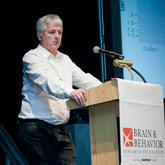New Insights into the Genetic Basis of Schizophrenia
New Insights into the Genetic Basis of Schizophrenia
Scientists who comprehensively analyzed patient data to test two different models for how schizophrenia might arise have concluded it is caused by multiple genetic abnormalities that result in a range of varied symptoms for individual patients. Their paper appeared online September 22 in Molecular Psychiatry.
The research team was led by Michael O’Donovan, M.D., Ph.D., 2012 Lieber Prizewinner, and lead author Katherine Tansey, of Cardiff University, UK; it also included Stephan Ripke, a 2015 NARSAD Young Investigator grantee and 2014 Sidney R. Baer, JR. Prizewinner; James T.R. Walters, M.D., Ph.D., a 2009 Young Investigator grantee; and Michael J. Owen, M.D., Ph.D., a 2012 Lieber Prizewinner.
In general, the mutations linked with schizophrenia can be divided into two groups: common and rare. Common mutations tend to be small, with only one or two DNA “letters” differing between affected and unaffected individuals. About 100 such mutations are now known, and they are found relatively frequently among individuals with the illness. But scientists have found that individually, each of these common mutations carries only a small risk for an individual to develop the disease; indeed, no single one alone is sufficient to cause schizophrenia.
In contrast, researchers have identified only a few rare mutations solidly linked to the illness. These changes, known as copy number variations (CNVs), represent a large rearrangement of the DNA. Each of the so-far identified CNVs is associated with a significantly higher risk of developing schizophrenia.
The researchers sought to test two different models for how both common and rare mutations might contribute to schizophrenia. One possibility is that each rare mutation is responsible for a specific form of the disorder; at its most extreme, this model suggests that people with schizophrenia may fall into distinct subgroups, each with a different mutation driving their symptoms.
Alternatively, the team proposed, schizophrenia may be caused by multiple mutations at once, with multiple mutations combining in any one person to contribute to different aspects of the pathology. In this way, the disease would manifest with symptoms that span a broad spectrum.
The researchers examined existing DNA data from patients to test the two models. They found that people with rare CNVs also had more common, small mutations; therefore, say the researchers, the disease cannot be classified into unique subgroups based upon mutations.
Instead, they suggest that each individual with the illness has multiple mutations that contribute to symptoms. These mutations cause symptoms that overlap in various patients, but they are not identical.
The research has significant implications as clinicians work to understand the pathology of the disease more deeply. Dr. O’Donovan and colleagues suggest that the absence of very discrete subgroups of patients defined entirely by a particular mutation suggests something important: that studies in which very rare mutations have been found that are likely to cause significant pathology are still likely to be applicable to the wider patient population.




